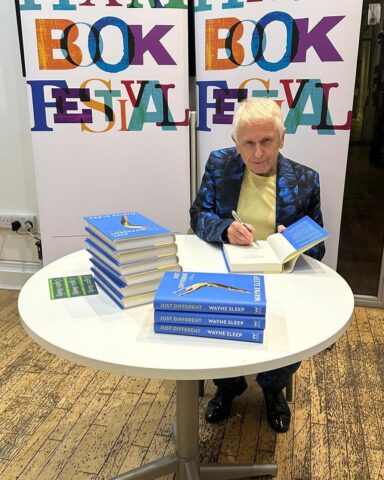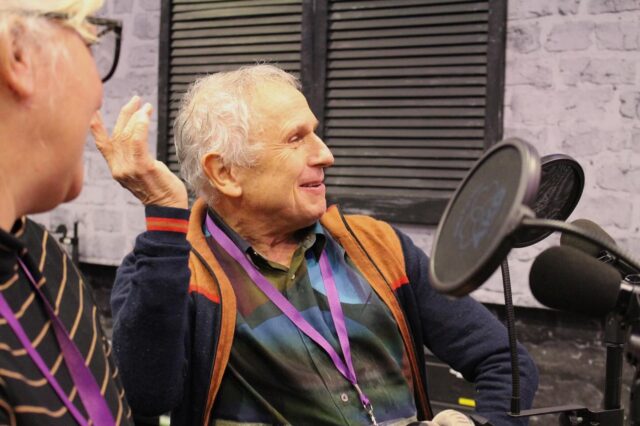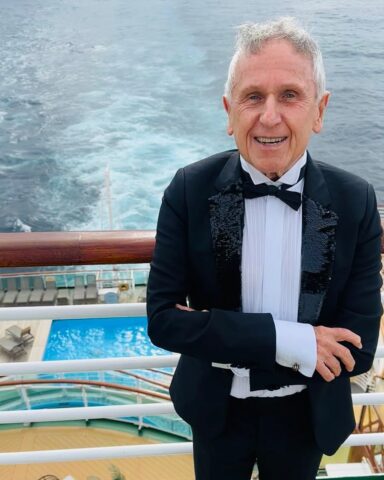Dancing with Diana: Wayne Sleep's lifetime onstage
World famous dancer Wayne Sleep is one of the headline events at this year’s Gibraltar Literary Festival. Mr Sleep discussed with reporter Eyleen Gomez his journey to winning a scholarship at the Royal Ballet, his diverse career, his collaboration with Princess Diana and his innovative shows that blended various dance styles.
You won a scholarship to the Royal Ballet out of 250 hopefuls, what do you remember about that moment, and how did that shape your determination?
Well, my dancing teacher said to my mother, there's a boarder scholarship going which will pay for him when he's 12 to 16 at Richmond Park in the Royal Ballet School as a boarder.
Why don't you put him in for it? My mother said ‘well, is he any good?’ My teacher says ‘well, he stands a chance’. She said, ‘why didn’t you tell me he was any good at it?’ The teacher said ‘I didn't want to make the other mothers jealous.’
So I remember that.
Anyway, I got on a train for an eight-hour journey and we found this studio in Hammersmith, and I was in line with another 200 or so hopefuls.
I thought, Well, that's it. It's over.
And by 4.30 that afternoon, there was only seven of us left, and they said, tomorrow, you'll take your son to Great Ormond Street Hospital to be x-rayed to see how tall he will be.
My mother said ‘oh, you can't we've got return tickets. We can't afford to stay tonight, etc’.
And if I had been able to afford to stay the night I probably would never have got in. Because it would have said I was only going to grow to 5ft 2, and you have to be 5ft 9 for ballet dancer.
So I remember it being fortuitous in a funny sort of way.
And I remember when I went there, it was just like a dream world right in the middle of Richmond Park. And we were able to just concentrate purely on our academic subjects, of course, and everything else. But we had one ballet class a day every day. So it wasn't like once a week on the bus going wherever. And that was the gift of it, I think.
And then we went to the Upper School, and then I stopped growing and it all changed.
What was the atmosphere like back in the Royal Ballet in the 1960s for a working class gay young man, breaking into such an elite place?
I was always brought up with good manners so I could hold my own anywhere. And that's what really it's all about. If you have manners, you can get through anything or any social climb.
And I didn't really see much difference.
But I did find we rather got spoilt as the boys, because there's only five boys to 20 girls in a class.
We got away with a lot, but I won't go into that.
But they definitely let us drop a couple of subjects if we didn't really want to do it, because we were doing so much dance. And the main thing was dance, but we had to have our academic degrees.They insisted on it, in case you don't
succeed in the dancing.
I remember going to see dress rehearsals at Covent Garden. We were allowed to sit in the amphitheater at school. And saw my first performance ever of a ballet when I got there, and it was [Margot] Fonteyn and [Rudolf] Nureyev dancing Giselle.
And it was just tremendous, we all wanted to do the same thing. All the students, we all strive for the same goal.

You just mentioned that you went to the see Margot Fonteyn and Rudolf Nureyev in Covent Garden and but you've also subsequently danced with them, correct?
Oh yes, for 12 years, actually.
What did they teach you about artistry and performance?
Well, Margot Fonteyn would practice a step for about six hours if she had to, and she would just not find any perfection in it until she really got near it.
And that tenacity and staying power really taught me that's what it is all about. And not to listen to other people if they bully you, or say ‘give up you’re too small, etc’, tenacity, staying power, going for it and not thinking anything else. And that's what she told me.
Rudolph was outrageous. I mean, he was a great guy and he was an amazing dancer, and he taught me a few things about like, this isn't the right floor or something like that. And I started to stand up for myself as well because he did. But he got away with it.
You branched out into multiple disciplines. What drove you to do that, as opposed to just stay with ballet?
I was only five foot two. There were several ballets where you were adjacent [to other dancers] and it would have been useless of me in a line of six boys, with it dipping in the middle. It would be ridiculous and a laughing stock.
So I couldn't do any of those ballets until my second year when parts were created especially for me, which was even better.
But I couldn't do the general repertoire because I didn't fit so I did feel a bit of a loose end.
So I started to learn jazz dancing from an American jazz teacher. I started learning tap. I started learning contemporary dance. Contemporary Dance was new in England. It didn't come into the early ‘60s, believe it or not.
I went to outside classes there, and so I had jazz, tap, contemporary and ballet at the best level. And so then, when I brought my own little show DASH together with eight dancers, I did under one roof in one evening ballet, jazz tap and contemporary.
And they already told me ‘oh you have gone commercial. If you want to see ballet, you go to ballet. Want to see this, you go to that’.
Well anyway, they all do everything now, but they didn't.

One of the things that you're most known for by people outside of the ballet world, even outside of the dance world, was your performance with Princess Diana. Can you tell me a little bit about what it was like collaborating and actually performing with her?
I didn't know her, and she asked to see me because she started doing dance with a friend of mine, and she wanted to see me. So I went along and saw her.
My first meeting with her, I'll never forget that. She was wearing a pink leotard, leg warmers, jazz shoes and a headband.
And I thought she goes all the way this one.
And she said wanted to dance with me at Christmas as a surprise for the King [Charles – then Prince of Wales].
And I thought, I'm not dancing with you. You're far too tall. I'm far too small, people will be hysterical laughing.
So I already got in my mind at that moment, I had some boy from Royal Ballet who I choreographed and I said he could do it.
Then I said to her ‘do you mind if we sit down?’ She said, ‘why?’ I said ‘I had an awfully late late night’, she said ‘naughty boy’.
And then I realised we could make it fun and one-up each other when I did a pirouette, she'd kick over my head, walk to the other side.
And then I lifted her right across the stage, and she loved it.
She wasn't nervous at all. I was nervous because I was scared to drop her. But she just basked in the spotlight like she was meant to do it all her life, and I think that's really one of the things that people miss.
She'd never performed live dancing. She'd done a dance, and the syllabus for a boarding school, but she never performed a dance, and this was her one moment to be able to do so, then she could tick off that box.
And also [the audience] went crazy, and she wanted to do it again. I said ‘No’ after eight curtain calls.
It was strange because I did a bit before, etc, etc. Then she walked on and there was no reaction, because they thought maybe it was a look-alike or something. And then when she walked again and stood, the whole theatre of 2600 people gasped in silence.
And then it started to warm up.
And it was a very controlled applause that got bigger and just overwhelming in the end. And she was thrilled she'd done it.
Your book, Just Different, explores feelings like being an outsider. How did those feelings influence your artistry and stage presence?
I think they made me totally independent.
I was determined to do what I wanted to do because I didn't think there was anything wrong in it.
I had different styles, I added humour, almost slapstick, vaudeville, vulgarity.
But the other main numbers were done brilliantly by the people of their craft.
And I've got other choreographers. And from there, we got the Hot Shoe show on TV. They based it on my show, because I was doing all the different styles.
So it wasn't like they're coming from ballet, but they were seeing brilliant boys dancing and everything.
And that's my humour of course, my takeoffs of [Olympic Ice skaters] Torvill and Dean, [tennis player] McEnroe and [Russian gymnast] Olga Korbut was the first one. Yeah, I suppose you could say I went commercial on that.
Remember, this was over 50 years ago. Everybody gets a size of cake now. But of course, then it was more difficult.

The Wayne Sleep Foundation has supported many young performers. What qualities do you look for in emerging talent?
The sparkle.
Something inside them that they can relate through their bodies or through their playing or their music or whatever. They have got to have something in them. That’s individual, that is going to change things or make things brilliant. ,
Obviously, technique and stuff, but that inner spark I'm always looking for that moment when they come alive. Something you cannot teach.
What piece of advice would you have for students who feel like they don't fit the mould, like you didn't with your height?
As [founder and director of the Royal Ballet] Ninette de Valois always said if ‘you're too small, don't take a pill or anything. Just jump twice as high as everybody else and turn twice as fast. And get on with it.’
So I would tell them to just tell them to get on with it. Do it. Don’t listen to anybody else.









